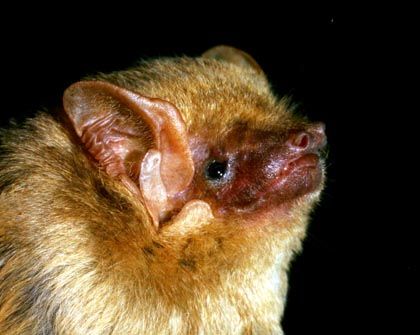
Northern Yellow Bat
Northern Yellow Bat
Northern Yellow Bat (Lasiurus intermedius floridanus)
(804) 729-0046 or toll-free at (888) 824-7383
I Have a Bat in the Attic of My Virginia Home. Get Rid of Bats in VA.
Characteristics
The Northern Yellow Bat is a large, pale, yellowish-brown bat with long wings. The ears are short, broad and rounded and the fur is long and silky, and the tips of the hairs are often gray or brown. The average total length is 115 mm (4.5 inches) and a wingspread of about 375 mm. The females are larger than the males. Mating occurs during flight in the fall (and occasionally winter), and although females may have three or four embryos in the spring, typically only twins are born in late May or early June. If their maternity roost is disturbed, mother yellow bats will pick up their pups and carry them to a safer roost. Baby bats become volant (able to fly) between June and August, and will form evening feeding aggregations with adult females while adult males remain solitary. The females form loose colonies during the breeding season. This species is solitary except for females in the breeding season. This species is seldom found in caves or buildings.
Distribution
The Northern Yellow Bat has only been found in the Norfolk region of Virginia. This species is lives mostly in loblolly pine or turkey oak, near water, often roosting in Spanish moss. This species is closely associated with Spanish moss (Tillardia usneoides), and the range closely approximates that of Spanish moss.
Foods
As all bats, the Northern Yellow Bat primarily eat insects of all kinds and this species forages approximately 15-20 feet above the ground. The majority of their diet is composed of true bugs, flies, mosquitoes, beetles, leafhoppers, flying ants, and on the rare occasion, damselflies and dragonflies.
For fast, safe and humane Virginia Bat Removal contact us at (804) 729-0046 or toll-free at (888) 824-7383. Call us for more questions on the Northern Yellow Bat in Virginia.
Our Service Areas Include:
Afton, Albemarle County, Alexandria, Amelia County, Annandale, Arlington, Ashburn, Ashland, Barboursville, Bellwood, Belmont, Bensley, Bermuda Hundred, Bon Air, Boyd Tavern, Brandermill, Bumpass, Burke, Central VA, Centreville, Chamberlain, Charlottesville, Chesapeake, Chester, Chesterfield County, Colonial Heights, Crozet, Cuckoo, CVille, Dale City, Doswell, Dumbarton, Earlysville, East Highland Park, Enon, Ettrick, Fairfax, Fair Oaks, Ferncliff, Fluvanna County, Fredericksburg, Genito, Glen Allen, Glenora, Goochland County, Gordonsville, Gum Spring, Hadensville, Hampton, Hampton Park, Hanover County, Harrisonburg, Harrogate, Hening, Henrico County, Highland Springs, Hopewell, Innsbrook, Jefferson Davis, Kents Store, Keswick, Lake Anna, Lake Monticello, Lake Ridge, Lakeside, Laurel, Leesburg, Lewiston, Lignum, Locust Grove, Louisa County, Maidens, Manakin, Manakin-Sabot, Manassas, Manchester, McLean, Montrose, Motoaca, Meadowbrook, Mechanicsville, Midlothian, Mineral, Moseley, Newport News, Norfolk, North Courthouse, North Garden, Oilville, Orange County, Palmyra, Pantops, Petersburg, Portsmouth, Powhatan County, Reams, Reston, Richmond, Richmond County, Robious, Rockville, Rockwood, RVA, Salisbury, Sandston, Sandy Hook, Scottsville, Shannon Hill, Short Pump, South Rockwood, Spring Run, Staunton, Stoney Point, Suffolk, Tidewater, Troy, Tuckahoe, Va, Varina, Virginia, Virginia Beach, Waynesboro, Williamsburg, Winchester, Winterpock, Woodlake, Wyndham, and the surrounding areas of Virginia.
We also trap, remove, capture, control, manage and exclude all Virginia Wildlife and Animal Pest Control.
Please Complete Our Simple Contact Form Below:
Go to the full page to view and submit the form.
